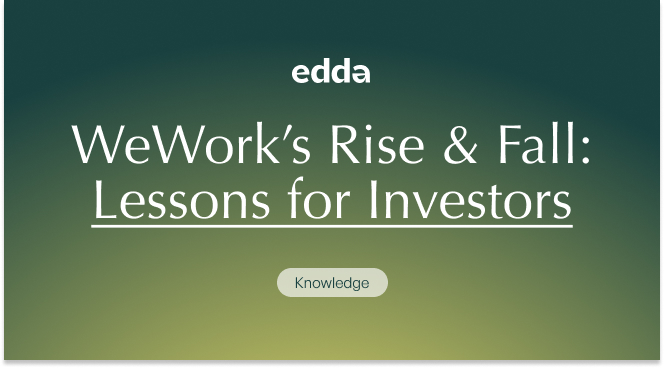WeWork’s ascent and subsequent downturn presents a thought-provoking case study in rapid corporate expansion, market alignment, and governance. Initially, WeWork redefined the traditional office space, drawing significant investment and expanding globally at an impressive pace. However, the unraveling of its growth strategy offers critical insights into the risks associated with aggressive expansion and the necessity of aligning business models with market realities.
Through the lens of WeWork’s experience, this article examines the crucial role of strategic oversight and analytics in investment decision-making, highlighting how platforms like Edda’s deal flow software suite are instrumental in navigating the complexities of the tech and real estate investment sectors.
WeWork’s Rise to Prominence
Before its abrupt reversal of fortunes, WeWork experienced a remarkable phase of growth, propelled by a unique vision of transforming traditional workspaces. At the heart of WeWork’s early success was its novel approach to the office environment, blending modern design with a community-focused ethos. This approach resonated with a new generation of workers, especially startups and freelancers, who were seeking more than just a physical space to conduct business.
The company’s rise was marked by rapid expansion, both geographically and in terms of its customer base. WeWork’s model of providing flexible, aesthetically pleasing workspaces with a range of amenities became a magnet for young professionals and companies who valued such environments. This appeal was not limited to small businesses; even large corporations began to see the benefits of such flexible and vibrant workspaces for their employees.
Financial backing played a significant role in WeWork’s momentum. Investment from major players like SoftBank signaled confidence in WeWork’s potential and enabled the company to scale up at an unprecedented rate. This influx of capital was crucial in allowing WeWork to rapidly increase its global footprint, entering new markets and acquiring properties at a pace that was almost unheard of in the real estate sector.
WeWork’s branding and marketing strategies also contributed significantly to its growth. The company successfully marketed itself as more than just a real estate venture; it was seen as a revolutionary concept in the world of work. Its emphasis on community, networking, and a shared economy resonated with contemporary work culture, making it an attractive proposition for a diverse range of clients.
However, this period of rapid growth and expansion also sowed the seeds for future challenges. The aggressive pursuit of market domination, fueled by substantial investment, led to overextension and raised questions about the sustainability of its business model.
As WeWork continued to grow, the need for a robust and sustainable operational strategy became increasingly apparent, a need that would soon become critical in the face of emerging challenges.
The Unraveling: Key Mistakes in WeWork’s Strategy
As WeWork’s trajectory shifted from rapid growth to a concerning decline, several critical mistakes became apparent, each contributing to the company’s challenges. These missteps offer valuable lessons in the delicate balance required in scaling a business, managing investments, and maintaining corporate governance.
Overlooking Market Realities and Economic Sustainability
One of the primary oversights was WeWork’s failure to align its growth strategy with realistic market conditions. The company’s expansion was based on optimistic market projections that did not fully account for economic fluctuations or the competitive landscape of commercial real estate. This miscalculation led to overexpansion in markets that could not sustain the growth, resulting in financial strain.
Governance and Leadership Concerns
Central to the company’s struggles were issues related to governance and leadership. WeWork’s leadership, particularly its CEO, Adam Neumann, faced criticism for decision-making that appeared to prioritize rapid growth over financial stability. Concerns included Neumann’s unconventional management style and personal conduct, which raised questions about the company’s internal controls and decision-making processes.
Inadequate Financial Oversight
Despite substantial investment, there was a lack of rigorous financial oversight. This shortfall manifested in high operational costs without a clear path to profitability. The company’s spending on new locations, amenities, and marketing outpaced its revenue growth, leading to unsustainable cash burn rates.
The Flawed IPO Attempt
The attempt to go public exposed many of these issues to a broader audience. The IPO filing revealed not just financial losses, but also complex financial arrangements that further eroded investor confidence. The scrutiny that comes with the IPO process brought to light the need for greater transparency and accountability in WeWork’s operations.
Underestimating the Importance of a Sustainable Business Model
WeWork’s business model, while innovative, did not fully consider long-term sustainability. The reliance on long-term leases and short-term memberships created a financial imbalance, particularly vulnerable in times of economic downturn. This model left little room for adjustment in the face of market changes, as evidenced during the initial stages of the COVID-19 pandemic.
Impact of External Economic Factors
External economic factors, such as changes in investor sentiment towards tech startups and the broader economic climate, also played a role. As the market environment became more cautious, especially towards businesses with high burn rates and uncertain profitability, WeWork’s valuation and business strategy came under increasing scrutiny.
Learning from WeWork’s Challenges: Key Insights for Investors
WeWork’s dramatic rise and fall offer vital lessons for stakeholders, particularly in the realms of real estate, technology, and venture capital. These insights emphasize the importance of a comprehensive and analytical approach to investment decisions.
The Necessity of Realistic Market Assessment
Key Takeaway: Conduct thorough market evaluations that reflect economic realities and business sustainability.
WeWork’s experience highlights the need for investors to critically assess the market viability of business models. This requires not just an understanding of current market conditions but also the foresight to anticipate potential economic shifts. Investors should evaluate whether business expansion plans are sustainable and resilient against market fluctuations.
Governance and Leadership Evaluation
Key Takeaway: Scrutinize the governance structure and leadership quality of investment targets.
The governance challenges at WeWork underscore the importance of strong, transparent, and accountable leadership in companies. Investors must look beyond charismatic leadership and evaluate the governance structures, decision-making processes, and the overall ethical compass of the company’s leadership.
Financial Due Diligence
Key Takeaway: Ensure rigorous financial scrutiny and oversight.
WeWork’s financial missteps demonstrate the critical role of comprehensive financial due diligence. This includes examining spending patterns, revenue models, and the path to profitability. Investors should be wary of high burn rates and unclear financial strategies, emphasizing sustainable growth over rapid expansion.
Understanding Business Model Viability
Key Takeaway: Assess the long-term viability and adaptability of the business model.
A key lesson from WeWork is the significance of a business model that balances innovation with economic sustainability. Investors should evaluate how a company’s revenue model aligns with its operational structure and whether it has the flexibility to adapt to changing market conditions.
Preparedness for External Factors
Key Takeaway: Factor in external economic and market trends in investment decisions.
The WeWork case illustrates how external factors, such as investor sentiment and economic trends, can impact a company. An awareness of these factors and their potential influence on business performance is essential for informed investment decisions.
Reinforce Your Venture Capital Tech Stack
The WeWork saga presents a compelling case for the utility of Edda’s deal management software suite in the investment industry, especially for navigating the complexities of rapidly expanding enterprises. Edda’s array of functionalities directly aligns with the core challenges encountered in the WeWork narrative, from strategic growth management to scrutinizing governance and ensuring financial stability.
This suite of VC tools offers a comprehensive approach to investment management, crucial for addressing the nuanced and layered challenges revealed by WeWork’s journey.
- Dealflow & Pipeline Management: This feature provides comprehensive oversight of the entire deal pipeline, crucial for managing investments. It enables efficient tracking from deal origination to close, ensuring that investments are made with a full understanding of market dynamics and business viability.
- Portfolio Management: This tool offers capabilities for monitoring and analyzing investment portfolios. For situations like WeWork, where financial sustainability and business model viability are in question, this feature allows investors to track key metrics and performance indicators in real-time.
- Financial Analysis and Due Diligence: Edda accelerates the due diligence process and provides robust financial analysis tools. These are essential for a detailed examination of financial health, spending patterns, and profitability paths, addressing the need for rigorous financial oversight.
- Market Education and Trend Analysis: The platform keeps investors informed about changing market conditions and economic factors, crucial for adapting investment strategies in a dynamic environment.
Edda’s deal flow CRM for venture capital is a vital resource for investment firms tackling complex scenarios like WeWork’s. It equips them with the necessary tools to understand, manage, and strategize effectively in the investment sphere, proving itself as an indispensable asset in guiding firms through the complexities of modern investments.









